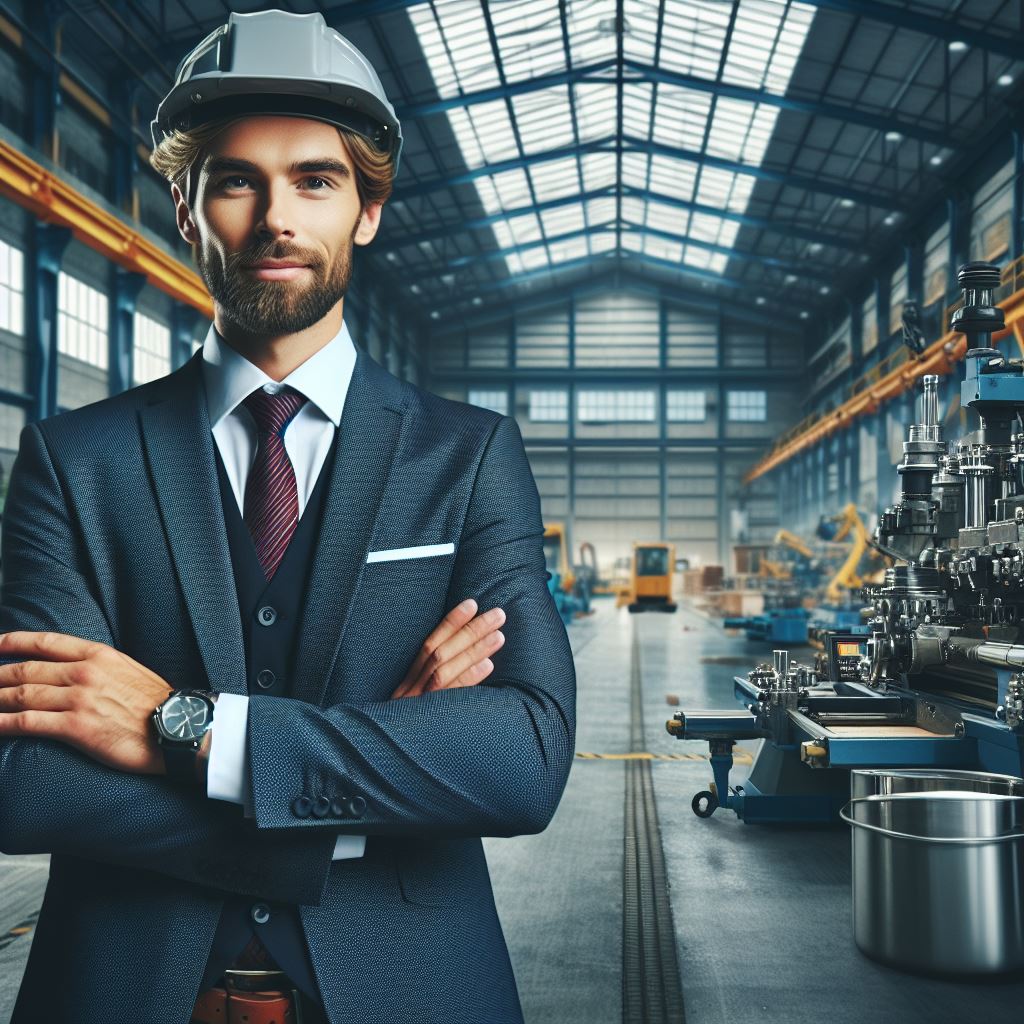Introduction
Industrial properties play a crucial role in our global economy, serving as the backbone of manufacturing and production.
As industries evolve, so do the environmental considerations surrounding them.
In recent years, a significant shift has occurred towards sustainable and eco-friendly practices within the industrial sector.
This post delves into the burgeoning realm of “Green Trends in Industrial Properties.”
Green trends in industrial properties refer to the adoption of environmentally conscious practices and technologies in the design, construction, and operation of industrial facilities.
These practices aim to minimize the ecological impact of industrial operations, promoting resource efficiency, waste reduction, and renewable energy utilization.
From sustainable materials to energy-efficient processes, green trends encompass a wide array of strategies to create a more environmentally responsible industrial landscape.
The integration of green practices in industrial properties is not just a trend; it’s a necessity.
Embracing sustainability brings forth a multitude of benefits, including cost savings, regulatory compliance, and enhanced corporate social responsibility.
By implementing energy-efficient technologies and waste reduction measures, industries can lower operational costs while mitigating their environmental footprint.
Furthermore, adopting green practices enhances a company’s reputation, attracting environmentally conscious consumers and investors.
The current landscape of green trends in industrial properties is marked by a growing awareness of environmental impact and a shift towards sustainable solutions.
From LEED-certified warehouses to carbon-neutral manufacturing plants, businesses are increasingly investing in green technologies.
Governments worldwide are also incentivizing green initiatives through grants and tax benefits, encouraging industries to adopt eco-friendly practices.
Key trends include the utilization of renewable energy sources, adoption of circular economy principles, and implementation of smart technologies for efficient resource management.
In the following sections, we will explore these green trends in greater detail, examining their applications and the transformative impact they have on industrial properties. Join us on this journey towards a greener, more sustainable industrial future.
Energy Conservation Measures
Implementation of energy-efficient lighting systems
Implementing energy-efficient lighting systems can significantly reduce energy consumption and costs.
Energy-efficient lighting technologies, such as LED or CFL bulbs, use less energy than traditional incandescent bulbs.
These lighting systems also have longer lifespans, reducing maintenance and replacement costs.
By installing motion sensors or timers, unnecessary lights can be automatically switched off when not in use.
Use of renewable energy sources such as solar or wind power
Incorporating renewable energy sources like solar or wind power is another green trend in industrial properties.
Solar panels can be installed on rooftops or open spaces to generate clean energy without emissions.
Wind turbines can be utilized in regions with consistent wind patterns to harness wind power and reduce reliance on traditional energy sources.
By adopting renewable energy, industrial properties can significantly lower their carbon footprint.
Application of energy management systems to monitor and reduce energy consumption
Energy management systems help monitor and track energy usage in industrial properties.
These systems provide real-time data on energy consumption, allowing facility managers to identify areas for improvement.
By analyzing energy usage patterns, adjustments can be made to optimize efficiency and reduce wastage.
Automated energy management systems can also schedule equipment usage during non-peak hours to lower energy demand.
Insulation and building envelope improvements for better energy efficiency
Insulation and building envelope improvements play a crucial role in minimizing energy loss.
Proper insulation helps maintain stable indoor temperatures, reducing the need for excessive heating or cooling.
Sealing air leaks and adding weatherstripping to windows and doors prevent drafts and improve energy efficiency.
Furthermore, upgrading windows to double or triple glazing can enhance insulation and reduce heat transfer.
In fact, industrial properties are adopting various energy conservation measures for a greener future.
Implementing energy-efficient lighting, utilizing renewable energy sources, applying energy management systems, and improving building insulation are all vital steps toward sustainability.
By prioritizing energy conservation, industrial properties can reduce their environmental impact and save on energy costs.
Read: Retail Investment: Hotspots in the US Market
Water Conservation Initiatives
Installation of low-flow fixtures and water-saving devices
In order to conserve water, industrial properties can install low-flow fixtures such as faucets, toilets, and showerheads.
These fixtures are designed to use less water without compromising performance.
Additionally, water-saving devices like aerators can be installed on faucets to reduce water usage.
Adoption of rainwater harvesting techniques
Rainwater harvesting is a sustainable practice that involves collecting and storing rainwater for future use.
Industrial properties can implement this technique by installing rainwater collection systems, such as rain barrels or cisterns, to capture rainwater from roofs.
This collected water can then be used for various non-potable purposes, such as irrigation or cooling systems.
Implementation of water recycling systems
Water recycling systems enable industrial properties to treat and reuse wastewater generated on-site.
This reduces the demand for freshwater sources and minimizes wastewater discharge into the environment.
Various technologies, such as membrane filtration and reverse osmosis, can be employed to purify the wastewater and make it suitable for reuse in industrial processes or for non-potable purposes.
Landscaping design with native and drought-resistant plants
Choosing native and drought-resistant plants for landscaping can significantly reduce water consumption in industrial properties.
These plants are adapted to local climates and require less water to thrive. By incorporating them into the landscape design, water usage can be minimized, and the need for irrigation can be greatly reduced.
Overall, the implementation of water conservation initiatives in industrial properties plays a crucial role in promoting sustainability and responsible resource management.
By installing low-flow fixtures and water-saving devices, industrial properties can significantly reduce their water consumption without sacrificing functionality.
Adopting rainwater harvesting techniques allows for the collection and reuse of rainwater, further reducing reliance on freshwater sources.
Water recycling systems ensure the proper treatment and reuse of wastewater, minimizing environmental impact.
Finally, landscaping with native and drought-resistant plants decreases the need for irrigation and conserves water.
Together, these initiatives contribute to the preservation of water resources and the overall sustainability of industrial properties.
By actively participating in water conservation, industrial properties can set an example for other industries and contribute to a greener future.
Read: Retail Foot Traffic: Analyzing Post-Pandemic

Waste Management Practices
In the pursuit of sustainable industrial practices, Waste Management emerges as a crucial aspect that can significantly impact environmental footprints.
In this section, we delve into four key strategies adopted by forward-thinking industrial properties to revolutionize their approach towards waste management.
Integration of Recycling Programs
The cornerstone of sustainable waste management is the integration of comprehensive recycling programs.
Industrial properties are increasingly focusing on recycling various materials like paper, plastic, and metal.
By implementing dedicated collection points and educating employees about proper disposal methods, these facilities ensure that recyclable materials are diverted from landfills, thereby reducing their ecological impact.
Implementation of Waste Reduction Strategies
Industrial properties are redefining their waste management ethos through better inventory management.
By closely monitoring and optimizing production processes, businesses can identify areas of waste generation and implement strategies to minimize excess.
This not only curtails the overall waste output but also contributes to cost-effectiveness, making it a win-win for both the environment and the bottom line.
Deployment of Waste-to-Energy Technologies
An innovative approach gaining traction is the deployment of waste-to-energy technologies.
Industrial properties are investing in systems that convert waste into usable energy, effectively turning a liability into an asset.
By harnessing energy from waste, these facilities not only contribute to renewable energy sources but also reduce dependency on conventional fossil fuels.
Collaboration with Waste Management Agencies
Recognizing the complexity of waste disposal and recycling, industrial properties are forging partnerships with waste management agencies.
This collaboration ensures that waste is disposed of responsibly, adhering to environmental regulations and ethical standards.
By engaging with experts in waste management, industrial properties can optimize their waste disposal practices, minimizing their ecological footprint.
In essence, the integration of these waste management practices marks a significant stride towards greener industrial properties.
By adopting recycling programs, implementing waste reduction strategies, deploying waste-to-energy technologies, and collaborating with waste management agencies, businesses can contribute to a more sustainable and environmentally responsible future.
Sustainable Material and Construction
In the realm of industrial properties, the pursuit of sustainable practices has become a cornerstone for responsible development.
As we delve into the fourth dimension of our exploration – Sustainable Material and Construction – we uncover the innovative trends reshaping the industrial landscape.
Use of Eco-friendly and Sustainable Building Materials
Gone are the days when industrial structures relied solely on conventional building materials.
Today, a surge in eco-consciousness has sparked a revolution in the choice of materials.
Sustainable alternatives like recycled steel, bamboo, and reclaimed wood are gaining prominence.
These materials not only reduce the environmental footprint but also add a distinctive character to industrial spaces.
Incorporation of Green Building Certifications and Standards
Acknowledging the urgency of environmental stewardship, industrial developers are increasingly adopting green building certifications and standards.
Certifications such as LEED (Leadership in Energy and Environmental Design) have become benchmarks for sustainability.
By adhering to these rigorous standards, industrial properties not only demonstrate their commitment to the environment but also stand out in the market as responsible and forward-thinking.
Integration of Green Roof Systems for Improved Insulation and Stormwater Management
The inclusion of green roof systems is transforming the tops of industrial structures into vibrant ecosystems.
These living roofs, adorned with vegetation, provide enhanced insulation, reducing energy consumption.
Additionally, they act as effective stormwater management systems, mitigating the impact of heavy rainfall and contributing to overall water conservation efforts.
Responsible Sourcing and Manufacturing of Construction Materials
The pursuit of sustainability extends beyond the finished product; it begins with responsible sourcing and manufacturing.
Industrial developers are placing a premium on materials with transparent supply chains, ensuring that every step of the production process aligns with eco-friendly practices.
By prioritizing responsibly sourced materials, the industrial sector is actively participating in the global movement towards a more sustainable future.
Basically, the fourth dimension of ‘Sustainable Material and Construction’ is steering industrial properties towards a greener horizon.
Through the conscientious use of eco-friendly materials, adherence to stringent certifications, integration of green roof systems, and emphasis on responsible sourcing, the industrial sector is not only meeting the demands of the present but also ensuring a resilient and sustainable future.
Read: E-Commerce vs. Physical Stores: The US Battle
Indoor Environmental Quality
Indoor environmental quality (IEQ) plays a significant role in the overall sustainability of industrial properties.
As businesses strive to create green and healthy workspaces, they are implementing various strategies to improve IEQ.
This section will discuss key trends in enhancing indoor environmental quality for industrial buildings.
Ventilation systems with advanced filtration for improved air quality
A major aspect of IEQ is air quality. Industrial properties are now incorporating ventilation systems with advanced filtration to ensure cleaner indoor air.
These systems effectively remove airborne pollutants, allergens, and contaminants, creating a healthier environment for occupants.
Utilization of non-toxic paints, adhesives, and materials to reduce indoor pollutants
Furthermore, the utilization of non-toxic paints, adhesives, and materials has become a common practice in green industrial properties.
By choosing eco-friendly alternatives, indoor pollutants and volatile organic compounds (VOCs) are significantly reduced, improving the overall air quality and reducing health risks for occupants.
Implementation of daylighting techniques for natural illumination
In addition to air quality, natural illumination is a crucial factor in creating a sustainable and healthy workspace.
Industrial properties are increasingly implementing daylighting techniques, which involve maximizing the use of natural light through strategic building design and the integration of windows, skylights, and light tubes.
This not only reduces the reliance on artificial lighting but also improves the occupants’ well-being and productivity.
Integration of biophilic design principles for improved well-being and productivity
Moreover, the concept of biophilic design has gained prominence in industrial properties aiming to prioritize the well-being of their occupants.
Biophilic design principles involve incorporating elements of nature into the built environment.
This includes green walls, indoor plants, and natural materials like wood and stone. Studies have shown that exposure to nature and natural elements can reduce stress, enhance cognitive function, and promote productivity.
By integrating biophilic design principles, industrial properties are creating a more pleasant and calming atmosphere, ultimately improving the well-being and creativity of their occupants.
In addition, biophilic design also contributes to a building’s overall sustainability by reducing energy consumption, improving air quality, and enhancing the aesthetic appeal.
All in all, the green trends in industrial properties are focused on optimizing indoor environmental quality.
Ventilation systems with advanced filtration, the use of non-toxic materials, daylighting techniques, and biophilic design principles all contribute to creating healthier and more sustainable workspaces.
These trends not only benefit the occupants’ well-being and productivity but also align with the growing importance of environmental sustainability.
Read: Anchor Stores: The Changing Dynamics in Malls
Economic Benefits and Market Demand for Green Industrial Properties
As industries evolve, so do the standards for sustainable practices.
In the realm of industrial properties, a growing trend towards eco-friendly initiatives has emerged, presenting a myriad of economic benefits and an escalating demand in the market.
Cost savings through energy and resource efficiencies
One of the primary economic advantages of embracing green practices in industrial properties is the substantial cost savings achieved through energy and resource efficiencies.
By adopting state-of-the-art technologies and sustainable designs, businesses can optimize their operations, reducing energy consumption and waste.
This not only aligns with environmental responsibility but also translates into tangible financial benefits.
Through smart investments in energy-efficient systems, industrial property owners can witness a significant drop in utility bills, bolstering their bottom line.
Increased property value and marketability
Green industrial properties inherently possess higher market value and enhanced marketability.
The shift towards sustainable practices has altered the landscape of real estate, with eco-friendly properties commanding a premium.
Investors and tenants alike recognize the long-term value of properties designed with environmental consciousness.
Such assets not only cater to the growing demand for responsible business operations but also guarantee a higher resale value in the future, making them an attractive proposition in the competitive industrial property market.
Growing demand from environmentally conscious businesses and investors
The market demand for green industrial properties is on an upward trajectory, driven by a surge in environmentally conscious businesses and investors.
Companies are increasingly recognizing the importance of integrating sustainability into their supply chain, and this extends to the properties they occupy.
Green industrial spaces are not just structures; they represent a commitment to corporate responsibility and a positive environmental impact, making them a preferred choice for businesses aiming to align their operations with a sustainable future.
Government incentives and tax benefits for green initiatives in industrial properties
Governments worldwide are actively promoting green initiatives in the industrial sector by offering a range of incentives and tax benefits.
From grants to tax credits, there are various financial rewards for industrial property owners who embrace sustainable practices.
These incentives not only cushion the initial capital investment in eco-friendly technologies but also contribute to the overall economic viability of green industrial properties.
Essentially, the economic benefits and increasing market demand for green industrial properties underscore a transformative shift in the industrial landscape.
From cost savings to heightened market value and a surge in demand from environmentally conscious stakeholders, the case for adopting sustainable practices in industrial properties is not just a matter of responsibility but a strategic investment in a greener and more prosperous future.
Case Studies and Success Stories of Green Industrial Properties
In the dynamic landscape of industrial properties, the emergence of sustainable practices has become paramount.
This section delves into inspiring case studies and success stories that showcase the transformative power of embracing green trends in industrial properties.
Notable Examples
- Tesla Gigafactories: Tesla’s commitment to sustainability extends beyond its electric vehicles. Gigafactories worldwide incorporate renewable energy sources, energy-efficient designs, and advanced waste management systems. These facilities set a benchmark for large-scale industrial operations with minimal environmental impact.
- Prologis Park Tracy, California: Prologis, a global leader in logistics real estate, has successfully implemented green technologies in their Tracy facility. The installation of solar panels and energy-efficient systems significantly reduced the carbon footprint while enhancing operational efficiency.
Environmental and Economic Outcomes
- Carbon Footprint Reduction: These green industrial properties have consistently demonstrated a substantial reduction in carbon emissions. Tesla, for instance, reported a significant decrease in its overall carbon footprint, aligning with its mission to accelerate the world’s transition to sustainable energy.
- Economic Advantages: The economic benefits of adopting green trends in industrial properties are evident. Lower energy consumption, reduced waste disposal costs, and improved resource efficiency contribute to long-term financial gains for businesses.
Lessons Learned and Best Practices
- Integrated Design Approach: Successful projects emphasize an integrated design approach that combines energy-efficient architecture, sustainable materials, and renewable energy sources.
- Community Engagement: Collaboration with local communities is crucial for garnering support and fostering a positive image. Prologis, for example, actively involves nearby communities in their sustainability initiatives, creating a shared commitment to environmental stewardship.
Inspire and Motivate Readers
As we explore these case studies, it’s clear that embracing green initiatives in industrial properties is not just an environmental responsibility but a strategic business move.
The success stories outlined here underscore the dual benefits of sustainability—positive environmental impact and enhanced economic performance.
Let these examples inspire and motivate readers to embark on their journey towards green industrial properties, contributing to a more sustainable and resilient future.
Conclusion
The surge in green trends within industrial properties marks a pivotal shift towards sustainability and environmental responsibility.
From energy-efficient lighting systems to eco-friendly waste management practices, embracing green initiatives offers a myriad of benefits.
Not only do these practices reduce operational costs, but they also contribute to a healthier environment, fostering a positive corporate image.
To industrial property owners and stakeholders, the call to embrace green practices is more crucial now than ever.
The economic advantages, coupled with a growing demand for sustainable business operations, make it a strategic move.
Initiatives such as installing solar panels, implementing water recycling systems, and adopting green building standards not only improve operational efficiency but also position businesses as leaders in the global push for sustainability.
As we navigate the path towards greener industrial properties, I invite readers to share their experiences and thoughts on this transformative journey.
Whether you’ve implemented sustainable practices or are contemplating making the shift, your insights can inspire others.
Together, we can build a community dedicated to fostering environmentally conscious industrial spaces.
In closing, the potential of green industrial properties extends far beyond the immediate benefits.
By adopting environmentally friendly practices, we pave the way for a sustainable future.
The convergence of economic advantages, environmental stewardship, and positive societal impact positions green industrial properties as beacons of progress.
Let us collectively embark on this journey, ensuring that our industrial landscape aligns with the principles of sustainability for generations to come.




